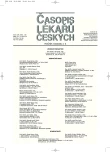Reduction of stuttering through bronchodilatation with β2 sympathomimetic drug formoterol
Authors:
J. Pešák 1; J. Zapletalová 2; T. Grézl 3
Authors‘ workplace:
Univerzita Palackého v Olomouci, Lékařská fakulta
1; Univerzita Palackého v Olomouci, ÚLB – pracoviště biometrie
2; Nemocnice v Kroměříži, Oddělení ORL
3
Published in:
Čas. Lék. čes. 2009; 148: 424-428
Category:
Original Article
Overview
Background.
About 60 millions of people on the planet suffer from stuttering. Speech fluency disorder caused by stuttering (F98.5) was known already in the ancient civilizations of Egypt, Mesopotamia and China 7000 years ago (1). Despite of this the aetiology of stuttering has remained unknown and its causal treatment has not been possible.
Methods and results.
According to ICD-10, 10th revision (2) ICD-10, stuttering belongs to „Other behavioral disorders including emotional ones with their beginning in childhood and adolescence“ (F98) and it is related to Chapter V „Mental and behavioral disorders“ (F00-F99). A multi-centre clinical study FORZAK-0503 (3), confirmed (4) hypothetical assumption (5) of the influence of pneumoobstruction of the tracheobronchal tree on the fluency disorder. Poetically spoken, the door opened towards causal reduction of speech disfluency accompanied often by tormentous stuttering (6).
Conclusions.
Besides publishing new findings on the aetiology of stuttering, it is needed to transfer stuttering under different classification and different identification code within ICD-10 (MKN-10).
Key words:
balbuties, fluency disorders of speech, stuttering, logophobia, bronchodilatation, β2 sympatomimetic, formoterol, ICD-10, MKN-10.
Sources
1. Guitar B. Stuttering. An Integrated Approach to its Treatment. 2th edition. Baltimore, Philadelphia, London, Paris, Bangok, Bueno, Hong Kong, Buenos Aires, Hong Kong, Munich, Sydney, Tokio, Wroclaw: Willims & Wikins 1998.
2. International Statistical Classification of Diseases and Related Health Probléme World Health Organization, Ženeva 1992.
3. Honová J, Pešák J. Výzkumný záměr MŠMT MSM 1521000018 „Ověřování vlivu bronchodilatace na plynulost řeči u nezletilých i dospělých s balbuties“ pokračovábí Výzkumného záměru MŠMT CEZ: J14/98: N30000018 „Integrované studium hlasu a řeči“.
4. Pešák J, Grézl T. Bronchodilatace β2 sympatomimetikem u balbuties. Sborník přednášek 15. semináře univerzitního Společenství pro studium hlasu a řeči Ed. Pešák J. Ústav lékařské biofyziky LFUP v Olomouci. Olomouc: září 2006.
5. Pešák J. Pneumoobstruction of the tracheobronchial tree as a hypothetical cause of balbuties. Medical Hypotheses 2002; 59 : 458–461.
6. Pešák J. Patentová listina. Použití přípravku ß2 sympatomimetika k omezení koktavosti. PV 31-03-2004. Úřad průmyslového vlastnictví ČR. Praha 2004.
7. Lašťovka M. Poruchy plynulosti řeči. Praha: Skriptorium, spolek pro nekomerční vydávání odborné literatury 1999.
8. Adams RD, Victor M. Principles of neurology. Information Services Company Furth Edition. New York, St. Louis, San Francisco, Colorado Springs, Auckland, Bpgota, Caracas, Hamburg, Lisabon, Madrid, Mexico, Milan, Montreal, New Delhi, Panama, Paris, San Juan, Sao Paulo, Singapore, Sydney, Tokyo, Toronto: McGraw-Hill 1989.
9. Pešák J. Psychotrofon 2. II. soubor přednášek 6. až 10. semináře univerzitního Společenství pro studium hlasu na řeči. Ediční řada – Sborníky. Olomouc, 15. 1. 2003. Olomouc: Univerzita Palackého v Olomouci 2003; 210–221.
10. Javorskij BM, Selezněv JA. Přehled elementární fyziky. Překlad: prof. RNDr. Miroslav Brdička. Praha: SNTL 1989.
11. Strejc V, a kol. Základy teorie samočinné regulace. Praha: SNTL 1958.
12. Veselý A. O léčení koktání /na základě spisu Sikorského. In: Sbírka přednášek z oboru lékařského., Ed. Prof. J. Thomayer, sv. 38–39, Serie IV. č. 8.–9. Praha: Bursík & Kohout 1893.
13. Svačina Š. Úvodník. Čas Lék čes 2009; 148 : 55.
14. Semann M. Poruchy dětské řeči. Praha: SZN 1955.
15. Pešák J. Zmírňování zadrhávání v řeči u dětí a mladistvých s balbuties po aplikaci β2 sympatomimetika formoterol. Klin Farmakol Farm 2004; 18 : 11–12.
16. Pešák J. Preliminary experience with formoterol for treatment of stuttering. Letters and comments. Annals of Pharmacotherapy 2004; 38 : 1323–1323.
17. Pešák J, Grézl T, Zapletalová J, Langová K, Modráčková L, Vodičková D. a kol. The study of the effect bronchodilatation on sérech fluency in stuttering. Brno: Scripta Medica 2006; 791 : 9–17.
18. Fibiger S, Herman FMP, Hafale AE, Neumann K. Health and human services for persons who stutter and education of logopedists in East-European countries, Journal of Fluency Disorders 2008; 33 : 66–71.
Labels
Addictology Allergology and clinical immunology Angiology Audiology Clinical biochemistry Dermatology & STDs Paediatric gastroenterology Paediatric surgery Paediatric cardiology Paediatric neurology Paediatric ENT Paediatric psychiatry Paediatric rheumatology Diabetology Pharmacy Vascular surgery Pain management Dental HygienistArticle was published in
Journal of Czech Physicians

Most read in this issue
- Receiver Operating Characteristic analysis and the Cost – Benefit analysis in determination of the optimal cut-off point
- Subacute thyroiditis confused with dental problem
- Fractional exhaled nitric oxide and its correlation with bioptic results in chronic cough patients
- Reduction of stuttering through bronchodilatation with β2 sympathomimetic drug formoterol
